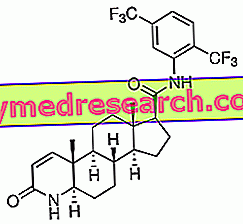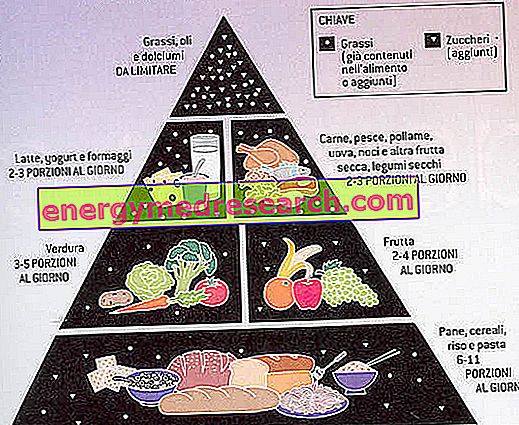What is Speck
The speck is a smoked sausage that can be placed in the group of "salted meats". It is a typical South Tyrolean product, designed by local people around the 13th century AD to preserve meat in the absence of more advanced equipment.
The starting material is the pork leg (binomial nomenclature: Sus scrofa domesticus ), which is the same as ham; however, the speck is distinguished from the latter by a different and characteristic process, which gives it unique organoleptic peculiarities of its kind.

Nutritional Properties
From a nutritional point of view, speck is a very energetic food, whose calories come exclusively from proteins (with a high biological value) and from lipids. The fatty acids contained in its triglycerides are predominantly of the unsaturated type, therefore they should not excessively harm the lipid metabolism. However, the absolute quantity of saturated fatty acids is quite high (1/4 of the total, equal to 5g / 100g of product) and this aspect, emphasized by the presence of cholesterol, assumes a certain health relevance (especially in the diet of hypercholesterolemic subjects ).
The glucides (except for traces of sucrose in the external portion), as well as the fibers, are absent; on the contrary, cholesterol seems significant.
As far as the saline profile is concerned, there is a noticeable sodium intake. The nutritional excess of this macroelement is involved in the onset and / or aggravation of arterial hypertension, which is why it is necessary that the speck, the other salty foods and the discretionary salt, be contextualized correctly to ensure the overall balance . An excellent portion of bio-available iron is not lacking, a micro-element particularly useful for fertile women, especially during pregnancy (during which it is however not advisable to take fresh or slightly seasoned salami, such as sausage, or artisanal production; speck, instead, it is considered relatively safe even for pregnant women at risk of toxoplasmosis). Also the potassium quota is relevant.
With regard to vitamins, the contributions of water-soluble molecules of group B (thiamine, niacin, cobalamin, etc.) are appreciable.
| Composition for: 100g of Speck - Reference values of the INRAN Food Composition Tables | |||||||||||||||||||||||||||||||||||||||||||||||||||||||||||||||||||||||||||||||||||||||||||||||||||||||||||||||||||||||||||||||||||||||||||||||||
 | |||||||||||||||||||||||||||||||||||||||||||||||||||||||||||||||||||||||||||||||||||||||||||||||||||||||||||||||||||||||||||||||||||||||||||||||||
Nutritional values (per 100 g of edible portion)
| |||||||||||||||||||||||||||||||||||||||||||||||||||||||||||||||||||||||||||||||||||||||||||||||||||||||||||||||||||||||||||||||||||||||||||||||||
Let us remember that speck is a food subjected to smoking, which certainly does not represent a healthy preservation method. Without triggering unnecessary alarms, it is important to specify that the high consumption of smoked foods is considered one of the many risk factors for the onset of stomach cancer.
Furthermore, since it is a preserved meat, the commercial speck contains discrete amounts of nitrites and nitrates. These are important molecules for maintaining healthy food (they prevent the development of Botox) but which, if taken in excess, are also implicated in the onset of stomach cancer.
It should then be specified that the association, in the same meal, of the speck with a dish rich in fresh vegetables, therefore of antioxidant and dietary fiber molecules, is able to mitigate the harmful effects of these potentially carcinogenic substances. However, this is an approximate indication that it has no "proportional" reliability.
The IGP mark - in the specific case of South Tyrolean speck "Südtirol" and in general for all other certified products - guarantees not only superior organoleptic characteristics, but also greater protection for the consumer's health (for example a reduced use of preservatives or flavor enhancers, widely used by the food industry to camouflage the poor quality of the raw material).
Like all preserved meats, speck should also be consumed with the right moderation, then in reduced portions (compared to fresh meat) and with a maximum frequency of once or twice a week. The massive presence of table salt and the significant presence of cholesterol and saturated fat make it a completely unsuitable product for those suffering from metabolic pathologies (in particular, hypercholesterolemia and arterial hypertension), those who are simply predisposed to it and those who has a higher cardiovascular risk than normal.
If used as a dish, the average portion of speck (better if deprived of visible fat) must be between 50 and 100g of product.
Gastronomic aspects
Speck can be used as a dish (in slices, similar to other cured meats), or as an ingredient in appetizers, first courses, unique dishes, pizza, special bread, etc .; in this case, the speck proves to be an excellent substitute (certainly not less valuable) than the traditional diced bacon, much richer in fat, cholesterol and calories.
WARNING! Speck based recipes can be raw or cooked; in the latter case I strongly suggest to AVOID the additional addition of table salt.
Some famous speck based recipes are: Tyrolean vol au vent, spatzle with cream and speck, various savory pies with speck, radicchio risotto wrapped in speck, etc.
Recipes
Risotto with Radicchio wrapped in Speck
Risotto with Radicchio and Speck
X Problems with video playback? Reload from YouTube Go to Video Page Go to Video Recipes Section Watch the video on youtubeOther Video Recipes with Speck
Production
First, the pork legs are carefully selected, boned and trimmed with or without topside; in the case of typical products - such as the speck of Alto Adige IGP - since these first phases, the producers must necessarily observe a strict production regulation.
The boned and trimmed pork leg is subjected to "dry" salting and aromatization. Precisely in this passage, the production disciplinary becomes less binding; in fact aromatic mixtures (generally including: salt, garlic, black pepper, juniper berries and sugars) differentiate the different productions of the various brands. It is not by chance that the individual producers pass on the "secret recipe" of their speck from father to son. Since it is traditionally carried out by hand, the entire operation requires careful care and involves turning the product several times in order to facilitate the uniform penetration of the brine.
After a period of 20-30 days, the pork leg is dried in a controlled atmosphere. Then it is smoked and matured at a temperature not exceeding 20 ° C. It is very important that the temperature of the smoke released (produced from non-resinous wood) does not exceed this value and that the food is exposed to air on a regular basis and then put back on smoking. Only in this way, in fact, can one obtain a speck with a balanced and unmistakable taste. This phase lasts about twenty days and is followed by a seasoning period of about 22 weeks, conducted in sufficiently ventilated rooms, at temperatures between 10 and 15 ° C and with humidity ranging between 60 and 90%. During this period, a thin layer of mold is formed on the surface of the speck; this is very important to maintain the humidity, sweetness and softness of its meat, in perfect balance with the typical smoky aftertaste.
The production phases just described reflect the artisan production method, as well as the certified one - with the appropriate additions - from the "Speck from Alto Adige PGI" brand. Obviously, the same care in the choice of raw materials and in compliance with the strict production regulations is not followed for other industrial products without certification.



